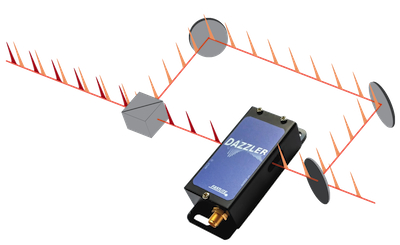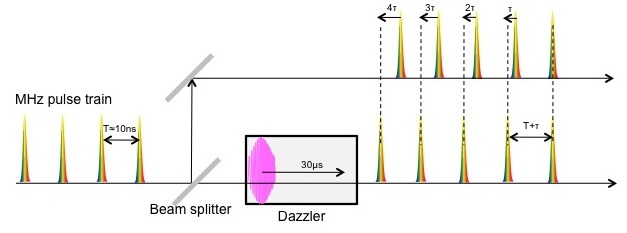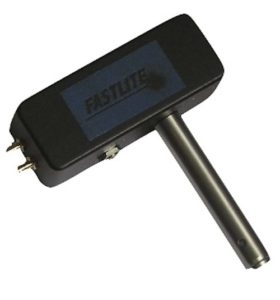
Delay line acousto-optic module
Dazzler configured for fast delay line application
Multi-kHz scan rate within a compact crystal module. No moving parts, no hysteresis.
Adapted to oscillators with pulse duration starting from 60fs and over, this low dispersion acousto-optic fast delay line opens the way to new kinds of Time Domain Spectroscopy, Frequency comb generation schemes, and high repetition rate pump probe experiments.
Originally demonstrated together with the group of Rupert Huber from the University of Regensburg, this new and patented application of the Dazzler takes advantage of the traveling acoustic pulse across the Dazzler birefringent crystal, leading to slightly different acoustic grating positions for each subsequent ultrafast oscillator pulse. During the propagation of the acoustic pulse, each subsequent oscillator pulse is diffracted with a few femtoseconds incremental delay. As a result, a 30µs-long complete acoustic pulse propagation results in an optical delay scan with attosecond-level accuracy, and a scanning rate of 30kHz.
The fast delay line thus acts as a frequency shifter, changing the diffracted pulses repetition rate by few Hz.

No moving parts, no hysteresis, since all delays are applied within the bulk of a crystal, this fast delay line is rock-stable and insensitive to evironmental conditions. Thanks to the Jitter-free electronics, the optical jitter introduced by the delay line is limited to typically 100as.
The dispersion offset between the first delayed pulse and the last one represents less than 5% change of the pulse duration for pulses longer than 60fs. Moreover, the delay line is still a Dazzler, thus keeping the capability to add some negative chirp to compensate for the dispersion of other components of the setup, such as fibers.
As already demonstrated here, the fast delay line surpasses all other delay generating techniques used in Time Domain Spectrometers in terms of scanning speed, without the classical drawbacks such as mechanical instabilities, hysteresis, or dispersion probems.
Its compactness makes it easy to integrate in any commercial or home made TDS setup.
While traditionnal setups require 2 mode-locked oscillators with slightly different repetition rates, using the fast delay line as a repetition rate shifter provides the same properties in a much more compact and stable way, since the amplitude and repetition rates of the 2 pulse trains are intrinsically stabilized with high precision.
The potential of the Fast delay line for this application has been demonstrated here.
Scan duration: 30µs
Scan range: 6 – 12 or 24ps
Number of delayed pulses per scan: 30µs / laser period (1500 pulses for a 50MHz laser)
Incremental delay: Scanning range / number of pulses (typically 4 – 8 or 16fs for a 50MHz laser)
For Yb-doped oscillators: HR1030
For Er-doped oscillators: HR1550
For both Yb and Er-doped oscillators: UHR-900-1700
For other wavelength ranges, please contact Fastlite.
| Mandatory for fast delay line applications.
This option locks the internal MHz clock of the Dazzler electronics with the MHz clock of the ultrafast oscillator. |
 |
To integrate easily the acousto-optic module after Yb and Er-doped fiber oscillators, Fastlite proposes an fiber-coupling option.
Please contact Fastlite for more information.
| O. Schubert et al: « Rapid-scan acousto-optical delay line with 34kHz scan rate and 15as precision » Opt. Lett. (2013) |
| I. Znakovskaya et al: « Dual frequency comb spectroscopy with a single laser » Opt Lett. (2014) |
| B. Urbanek et al: « Femtosecond terahertz time-domain spectroscopy at 36kHz scan rate using an acousto-optic delay » APL (2016) |
| X. Audier et al: « Pump-probe micro-spectroscopy by means of an ultra-fast acousto-optics delay line » Opt. Lett. (2017) |
| M.S. Alshaykh et al: « High-speed stimulated hyperspectral Raman imaging using rapid acousto-optic delay lines » Opt. Lett. (2017) |

